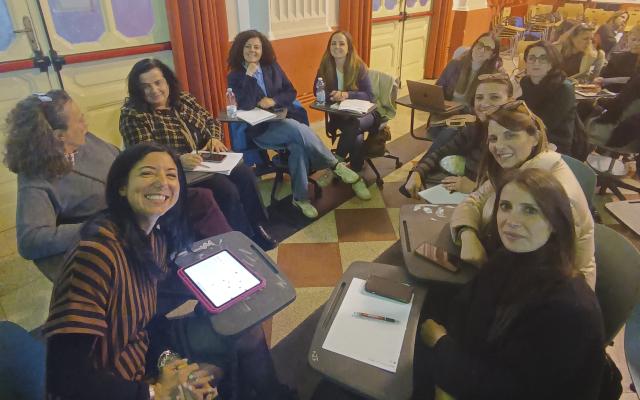Federico II's challenge to combat bullying and cyberbullying with artificial intelligence
Yesterday, the University of Naples Federico II hosted the third stage of the national tour DisclAImer. Last warnings before the revolution, promoted by Corriere della Sera in collaboration with Cineca and coordinated by Riccardo Luna.
The meeting, dedicated to the theme “AI and crime”, explored the risks and opportunities of increasingly pervasive artificial intelligence, which is now called upon to respond to even the most urgent social emergencies.
The Fondazione Mondo Digitale participated in the initiative as a knowledge partner, bringing concrete experiences and tools for the ethical, inclusive and educational use of AI.
The challenge: smart technologies to combat bullying and cyberbullying
The day began with a challenge dedicated to university students and young researchers: “Smart technologies to combat bullying and cyberbullying”. From 3 to 5.30 p.m., the teams worked on real scenarios, developing innovative, ethical and inclusive solutions. The immersive activity, led by Professor Carlo Sansone and researchers Stefano Marrone, Antonio Galli and Michela Gravina, allowed participants to explore the potential of artificial intelligence to identify and prevent risky behaviour in school and digital contexts.
The challenge drew on the results of the BullyBuster project, developed with ministerial funding and aimed at developing AI- and computer vision-based tools to combat bullying and cyberbullying.
‘The systems we develop,’ explained Professor Sansone, ‘can provide a dashboard for those who need to monitor risky situations, integrating text, video and language analysis to identify offensive or potentially dangerous behaviour in advance.’
The event was preceded in the early afternoon by a workshop organised by Umana dedicated to the soft skills – critical thinking, communication and flexibility – that are essential for tackling academic and professional challenges in the age of artificial intelligence.
The teams' solutions: prevention, empathy and reintegration
Five projects were presented by the university students, all geared towards the responsible and humane use of artificial intelligence. Aura proposed a video and audio analysis system capable of detecting risky actions and conversations in real time, in accordance with the principles of the AI Act and with the aim of protecting women from violence and discrimination. Calcina focused on prevention, favouring predictive and educational strategies over punitive measures. EmpatIA designed an app that supports parents and children with a non-invasive approach, capable of monitoring digital signals and suggesting educational interventions. EyeLighted presented a model that integrates images from public cameras, social data and light mapping to flag dangerous situations for women in unsafe urban spaces. Finally, Rise has expanded the Sidet prison system with three predictive modules to reduce the risk of recidivism and promote the social reintegration of prisoners.
The plenary session: between risks, sovereignty and new challenges
This was followed by a plenary session bringing together representatives from the institutional and academic worlds to explore the implications of artificial intelligence in the fields of security and justice.
Taking a critical and pragmatic view, Nicola Gratteri, Public Prosecutor of Naples, highlighted how “artificial intelligence is transforming the investigative and criminal justice system”, but not without risks.
“There are issues of confidentiality and secrecy in investigations,” he explained, “in a context where AI is owned by a limited number of companies. It is a very powerful technology in the hands of a few, and the reassurances provided on the use of data and cyber attacks are not yet sufficient. There is a serious issue of technological sovereignty of the state”.
Gratteri also pointed out that mafias are already using AI systems ‘to plan navigation routes, drug trafficking and criminal logistics,’ emphasising the need for ‘the judicial authorities to quickly equip themselves with tools to combat increasingly sophisticated crimes.’
Finally, he warned of the country's lag: “Italy is behind France and Germany. Five years ago, we were a benchmark, but today there is a huge technological gap that we must quickly bridge”.
In his speech, Bruno Frattasi, Director General of the National Cybersecurity Agency, described artificial intelligence as “a powerful ally, but also a threat in the cybernetic dimension”.
‘AI has two sides: it can generate new vulnerabilities, but at the same time it is the most effective tool to counter them,’ he observed. ‘Today's criminal threat is structured like a real supply chain, and the most dangerous remains ransomware, which acts on two levels, the digital and the economic.’
Frattasi pointed out that ‘€623 million has been allocated from the PNRR (National Recovery and Resilience Plan) for the digital transition,’ but added that ‘we are a little more secure, although not enough. Cybersecurity is, first and foremost, data protection. And data today is also a matter of sovereignty: we buy technology from the United States because in Europe we have few big tech companies capable of offering competitive alternatives.’
A final thought concerns human capital: “In Italy, the skills are there, but we have to fight to retain them. We must be able to attract and nurture talent”.



